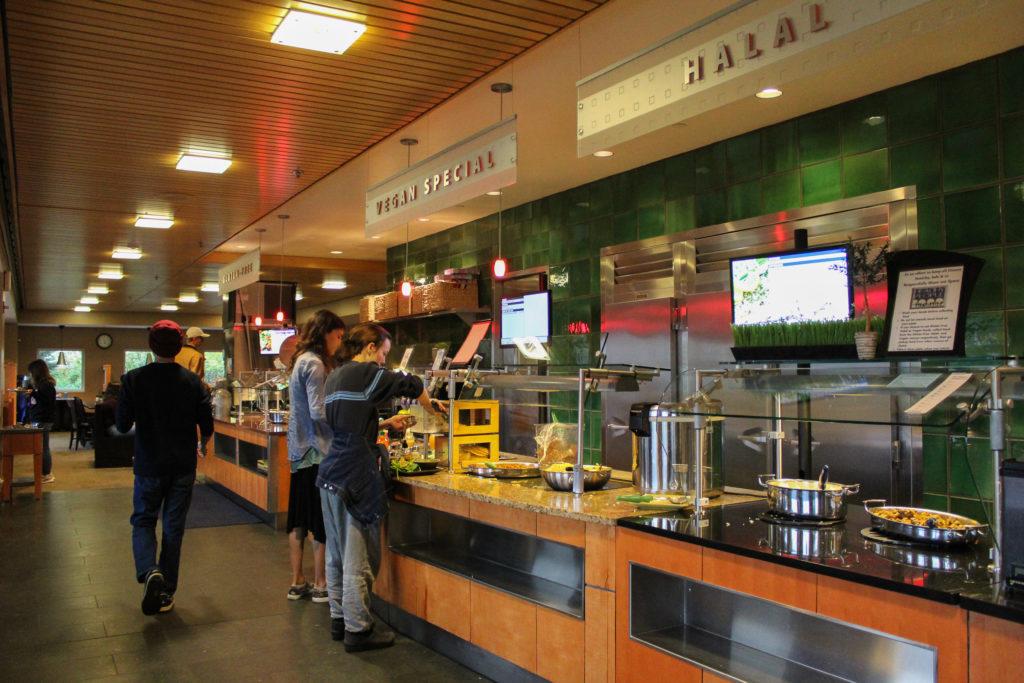By Shabana Gupta
guptasha@grinnell.edu
Last Thursday, during the Russian-themed food night at the Dining Hall, inadequate labeling of food caused difficulty for some students with various food sensitivities.
Katie Herbert ’20, whose main sensitivity is to nuts, was one of the students who struggled to find sufficient food options that day.
Before entering the Dining Hall, Herbert claimed to have checked NetNutrition, the website that allows people to view what the Dining Hall is serving on a weekly basis. Herbert said she often does this to see what foods she can eat at a given meal. Many of the dishes included walnuts, and, as the names of the dishes were in Russian, Herbert was not able to decipher what each dish was.
Herbert recalled arriving at the Dining Halland taking a to-go box to the grilled chicken section. All of the screens were malfunctioning, showing a white screen instead of the menu. The student worker at the station could not tell her most of the ingredients in the bowl of beans, and Herbert proceeded to take the beans back to her room in Cowles, without knowing that nuts were inside.
“I’m sitting there on the couch, and I start to eat the beans and thought ‘this tastes interesting but a bit weird,’” said Herbert, “I start to feel a bit off, so I look a bit more closely, and I’m like ‘no, this is definitely a nut.’”
After spitting out what was left in her mouth, Herbert went upstairs to take an antihistamine.
“Luckily I’m no longer at the point where I’m anaphylactic because then I would have had to use an EpiPen,” she said.
At that point, her food had been cross-contaminated and she was not able to finish the rest of her meal.
During the Russian-themed night, the screens were down for approximately 15-20 minutes.
“It is very unfortunate and scary for persons with medical dietary restrictions and for Dining Services that this sign malfunctioned and re-iterates the concern for proper information to be given to our guests,” Director of Dining Services Jeanette Moser wrote in an email to The S&B. Dining Services believe the malfunction has been fixed and want to remind people that NetNutrition has information regarding allergens in each dish.
Moser says it important for students to alert the dining staff when screens are down. “Career staff cannot see the sign for their area and are thus dependent on others walking by or in line at their venue to notice their sign is not working,” Moser wrote.
Katie Lou McCusker ’19 also had issues with getting food at the Dining Hall that night. Being allergic to both gluten and walnuts, the majority of the foods served were inedible for her.
She also noted that the labeling system has been faulty in the past.
“It happens more than you’d think. The labels don’t match up with the dish and then it’s hard to figure out if you can eat it or not,” said McCusker. In addition, labels are not placed with leftover dishes, causing people with allergies to avoid them entirely.
In addition to faulty labeling practices, some problems are caused by other diners.
“I’ve seen people come to Gluten Free and they have bread on their plate, and they’ll pick up the food and touch the gluten-free spoon to their plate,” McCusker said. For someone who is celiac, that instance of cross-contact can have extreme problems later on. Diners are meant to use a new plate when returning for second portions of their meal to avoid cross-contact.
Moser ensures that while major allergens are used within the kitchens, precautions are taken so that no cross-contact occurs.
“Our full-time staff are all trained and most are certified Servsafe food handling professionals,” she wrote. The certification requires knowledge about how to prepare foods in ways that prevents cross-contact.
Food for the allergen-free sections uses pans that are entirely cleaned, and the surfaces are cleaned so the opportunities for cross-contact are minimized. All allergen-free foods are stored in a separate hot box used only for allergen-free items of the same time. In addition, the ovens are able to be washed before baking allergy-free foods. All cutting boards are color-coded and are only used for the foods they are intended. The set up within each section is specific for each food. The last item on the line-up should be the only item to contain nuts in order to prevent cross-contact.
While students have faced certain difficulties in the past, Moser and the Dining Hall staff remain committed to providing a safe and enjoyable experience for students and faculty.




















































